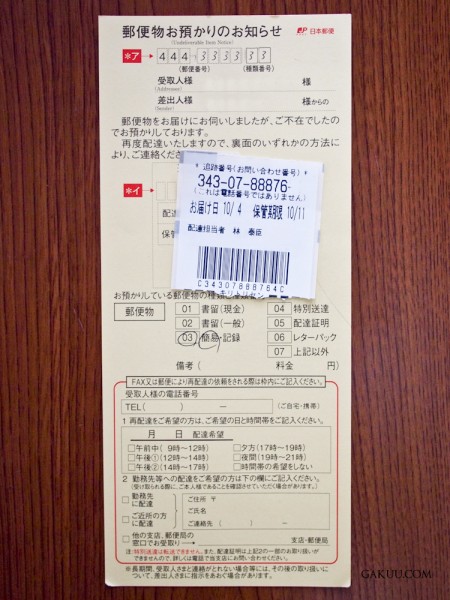A while ago we looked at notice you might receive in the mail. In contrast, this time we’ll actually examine the cards issued when you have an undelivered item.
In part 1, we’ll look at the front of the card and some of the vocabulary you’ll need to understand it. The cards come in at least two varieties, white and yellow, but have largely the same format as one another.
郵便物等お預かりのお知らせ
ゆうびんぶつ など おあずかりの おしらせ
Undelivered Item Notice
預かる (あずかる) means to keep hold of something or to look after it.
郵便番号 (ゆうびん ばんごう) – Post Code
受取人様 (うけとりにん さま) – Addressee
差出人様 (さしだしにん さま) – Sender
配達日時 (はいたつ にちじ) – Time of Delivery
保管期限 (ほかん きげん) – Holding Period
This is the length of time your item will remain at the Post Office. Usually a week or two.
お知らせ番号 (おしらせ ばんごう) – Item Number
配達担当者 (はいたつ たんとうしゃ) – Delivery Person
Below that, we have a little bit of keigo talking about the card being an Undelivered Item Notice. The part to pick up here is:
再度配達いたしますので、裏面のいずれかの方法により、ご連絡ください。
さいはいたつ いたしますので、 うらめんの いずれかの ほうほうにより、ごれんらく ください。
This sentence asks you to check the reverse of the card (裏面), choose a method for re-delivery (いずれかの方法により) and contact the post office (ご連絡ください). により means ‘by method of’, and with いずれか it becomes ‘by some method’ or ‘by one of the methods’ (shown on the reverse of the card).
We’ll look at the various methods and how to apply in detail in the next post, but before that let’s look through the types of mail listed on the card.
内国郵便物
ないこくゆうびんぶつ
Domestic Mail
We have:
定形外 (ていけいがい) – Irregularly shaped items.
ゆうメール (ゆうメール) – Yu Mail (for sending books, CDs, DVDs (etc) more cheaply than regular mail.
未納通常 (みのうつうじょう など) – Mail with an outstanding balance (such as unpaid import duty or customs tax).
国際郵便物
こくさいゆうびんぶつ
International Mail
書留・保険付 (かきとめ・ほけんつき) – Registered mail / Insured mail.
税付 (ぜいつき) – Mail with unpaid import duty.
上記以外 (じょうきいがい) – Other / Different to the above.
国際小包・EMS (こくさいこづつみ・EMS) – International small packages / Express Mail Service packages.
税付国際小包 (ぜいつきこくさいこづつみ) – International small packages that have incurred import duty.
備考 (びこう) – Notes / Extra information.
引換金額 (ひきかえきんがく) – Amount to be paid (usually for import duty / customs tax).
Looking at the yellow card we find there isn’t a lot of difference.
You’ll notice a sticker attached with the words:
追跡番号(お問い合わせ番号)
ついせき ばんごう(おといあわせ ばんごう)
Tracking Number (Enquiry Number)
This is just an alternative to the Item Number on the white form. It’s pretty much the same thing – when arranging to have your mail re-delivered, you need to tell the Post Office this number.
At the bottom of both forms is a box for you the customer to fill in if you intend to reply by post or fax. Start by filling in your phone number at the top, followed by the date and time you would like the item re-delivered. Then, in the second part you specify where to have the item delivered. You can choose your workplace (勤務先 – きんむさき), your next-door neighbour (ご近所の方 – ごきんじょのかた) or to a postal branch office for your to pick up (他の支店、郵便局 – ほかのしてん、ゆうびんきょく). Be sure to write the address of your workplace of neighbour if checking that option!
In the next post, we’ll take a look at the reverse side of this Undelivered Item Notice for details on how to arrange re-delivery by phone and internet. It can be quite daunting the first time you do it, but it’s actually quite simple!


Leave a Reply